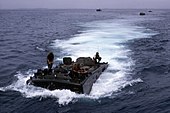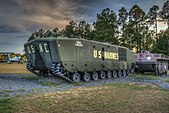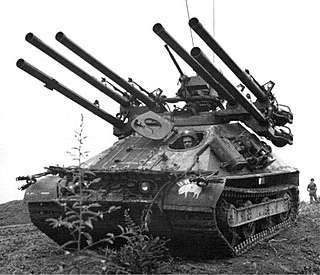
Ontos, officially the Rifle, Multiple 106 mm, Self-propelled, M50, was an American light armored tracked anti-tank vehicle developed in the 1950s.

The M3 Stuart/light tank M3, was an American light tank of World War II. An improved version of the tank entered service as the M5 in 1942 to be supplied to British and other Commonwealth forces under lend-lease prior to the entry of the U.S. into the war. Afterwards, it was used by U.S. and Allied forces until the end of the war.

The Assault Amphibious Vehicle (AAV)—official designation AAVP-7A1 —is a fully tracked amphibious landing vehicle manufactured by U.S. Combat Systems.

A flame tank is a type of tank equipped with a flamethrower, most commonly used to supplement combined arms attacks against fortifications, confined spaces, or other obstacles. The type only reached significant use in the Second World War, during which the United States, Nazi Germany, Soviet Union, Italy, Japan, and the United Kingdom all produced flamethrower-equipped tanks.

The Amphibious Vehicle, Tracked (LVT) is an amphibious warfare vehicle and amphibious landing craft, introduced by the United States Navy and United States Marine Corps. The United States Army, Canadian Army and British Army used several LVT models during World War II, and referred to those vehicles as "Landing Vehicle, Tracked."

The Philippine Navy (PN) is the naval warfare service branch of the Armed Forces of the Philippines. It has an estimated strength of 24,500 active service personnel, including the 10,300-strong Philippine Marine Corps. It operates 82 combat vessels, 14 auxiliary vessels, 25 manned aircraft and 8 unmanned aerial vehicles. Tracing its roots from the Philippine Revolutionary Navy on May 20, 1898, while its modern foundations were created during the creation of the Offshore Patrol in February 9, 1939, the PN is currently responsible for naval warfare operations and maritime patrol missions within the Philippine Waters, as well as ensuring the protection of the Philippine's maritime interests, including the West Philippine Sea and Benham Rise.

USS Tuscaloosa (LST-1187) was the ninth of the Newport-class tank landing ships of the United States Navy, which replaced the traditional bow door-design tank landing ships (LSTs). The vessel was constructed by the National Steel and Shipbuilding Company in San Diego, California and was launched in 1969 and commissioned in 1970 and the second ship of the United States Navy to be named after the city of Tuscaloosa, Alabama. The LST participated in the Vietnam War and was decommissioned in 1994. The ship was laid up until being sunk as a target ship during a sinking exercise in 2014.

The Cadillac Gage Commando, frequently denoted as the M706 in U.S. military service, is an American armored car designed to be amphibious. It was engineered by Cadillac Gage specifically for the United States Military Police Corps during the Vietnam War as an armed convoy escort vehicle. The Commando was one of the first vehicles to combine the traditionally separate roles of an armored personnel carrier and a conventional armored car, much like the Soviet BTR-40. Its notable height, amphibious capability, and waterproofed engine allowed American crews to fight effectively in the jungles of Vietnam by observing their opponents over thick vegetation and fording the country's deep rivers.
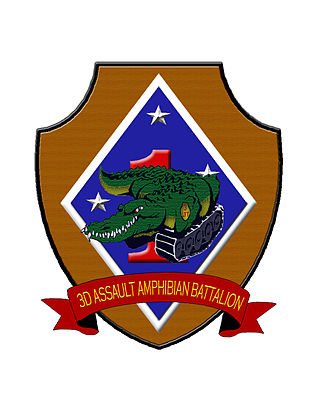
3rd Assault Amphibian Battalion is one of two active duty assault amphibian battalions in the United States Marine Corps. The battalion's primary weapon system is the Amphibious Assault Vehicle or AAV. The AAV is a 27.5-ton armored vehicle that carries up to 21 combat-loaded Marines and is armed with the UGWS, which mounts a .50 cal (12.7 mm) M2HB machine gun and a Mk-19 40 mm grenade launcher. The battalion is also equipped with the Amphibious Combat Vehicle or ACV, a rather new variant to the USMC’s amphibious armament which will replace the AAV in years to come. The AAV and ACV are the only armored vehicles in the U.S. inventory that are fully capable of operations both on land and in the ocean. The battalion is part of the 1st Marine Division and the I Marine Expeditionary Force. The unit is based in Camp Pendleton, California.

This article deals with Sherman tanks extensive use around the world after World War II and catalogues foreign post–World War II use and conversions of Sherman tanks and variants based on the Sherman chassis.

The Philippine Marine Corps (PMC) is the marine corps of the Philippines, a naval infantry force under the command of the Philippine Navy. The PMC conducts amphibious, expeditionary, and special operations missions.

The M35 2½-ton cargo truck is a long-lived 2½-ton 6×6 cargo truck initially used by the United States Army and subsequently utilized by many nations around the world. Over time it evolved into a family of specialized vehicles. It inherited the nickname "Deuce and a Half" from an older 2½-ton truck, the World War II GMC CCKW.
In the United States Marine Corps, the ground combat element (GCE) is the land force of a Marine Air-Ground Task Force (MAGTF). It provides power projection and force for the MAGTF.

The Bravia Chaimite is an armored vehicle with all wheel drive axles built by the Portuguese company Bravia and used by the Portuguese Army in the Portuguese colonial wars in Angola, Mozambique and Portuguese Guinea, from 1967 to 1974 when it ended. The Chaimite was originally an unlicensed derivative of the Cadillac Gage Commando assembled and later produced in Portugal, with a number of improvements and technical modifications.

The 75mm Pack Howitzer M1 was a pack howitzer artillery piece used by the United States. Designed to be moved across difficult terrain, gun and carriage could be broken down into several pieces to be carried by pack animals.

The Type 08 is a family of eight-wheeled amphibious, modular armored vehicle developed by Norinco for infantry fire support, battlefield logistics, and quick reaction operations. Developed in the early 2000s, the modern Chinese vehicle family were produced for more than 6000 hulls and widely deployed by the People's Liberation Army Ground Force and People's Liberation Army Marine Corps.
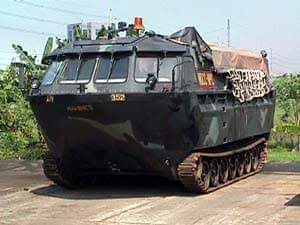
Aquatrack was developed by Glover Webb, which is a part of GKN Defense. The vehicle is a fully Amphibious Load Carrier with a 5 tonne cargo capacity, capable of carrying a vehicle, stores, or personnel on land and sea. Driven by its tracks or twin variable pitch propellers or both together, it can adapt to harsh environment such as mud, soft sand or frozen waste without any preparation. It moves from land into river, lake, or rough seas.

